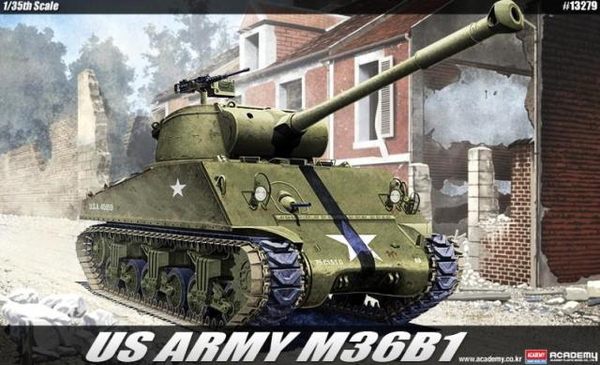
Academy 1/35 M36B1 Jackson
By Eric Christianson
Summary
Academy is back again with another version of the venerable M36 Jackson, proving they are still the go-to source for models of 1/35th scale late World War II U.S. tank destroyers. This kit contains parts for the M36B-1, redesigned to be equipped with a 90mm turret on the M4A3 Sherman body, a new sheet of photo etch parts for the light guards, a new engine deck, VVSS suspension and T48 caterpillar track. Academy provides a lot of detail inside the open turret, as will all of their tank destroyer kits, and hatches that can be posed in the open position, with interior (hatch) detail.
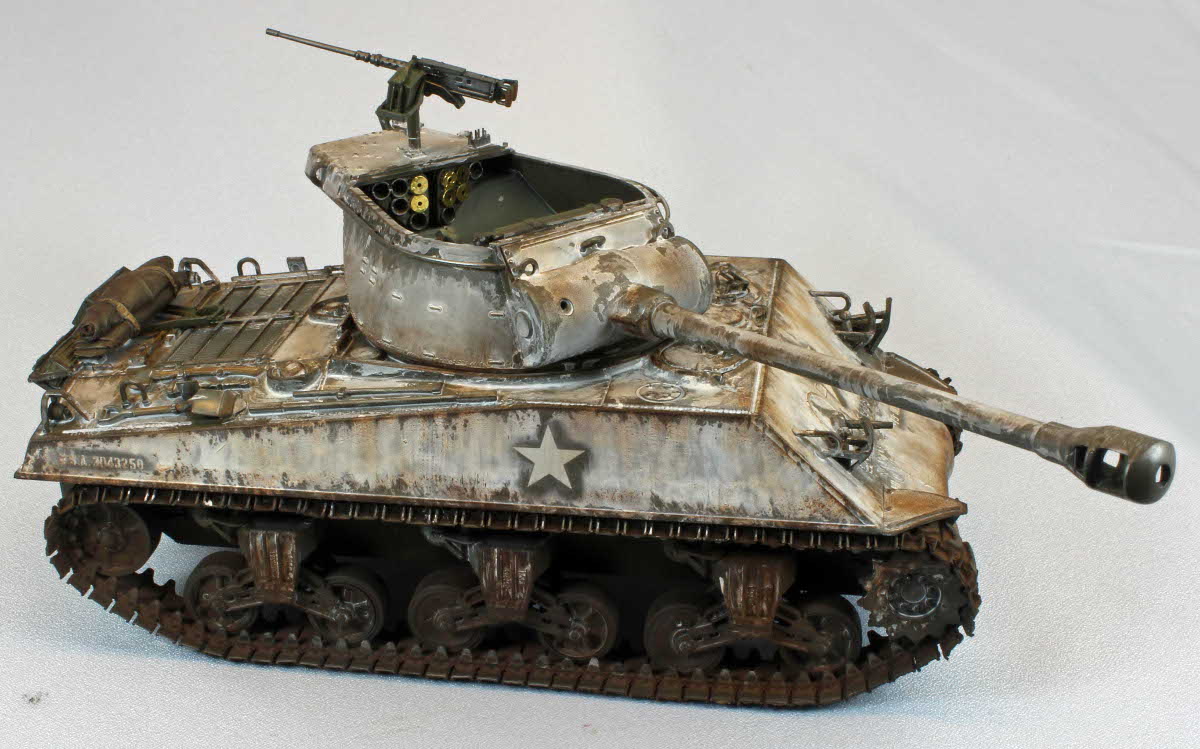
Background
The M36 Jackson, known formally as the '90 mm Gun Motor Carriage, M36', was an World War II American tank destroyer. American soldiers usually referred to them as TDs for 'tank destroyers'. The M36 first served in European combat in September 1944. It served until the end of World War II and also during the Korean War, and in the armies of several other countries.
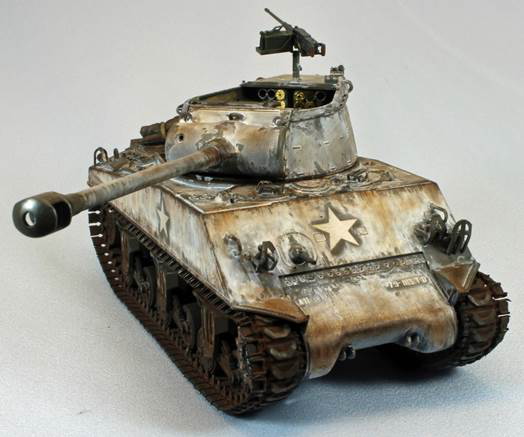
The 3 inch Gun Motor Carriage, M10, the standard U.S. tank destroyer, was rapidly becoming obsolete with the advent of heavy German armor such as the Panther and Tiger. Its main armament, the 3 inch M7 gun, had difficulty engaging these new tanks at distances greater than 500 yards. The turret was open-topped, like all US tank destroyers to save weight and provide better observation. It featured a large bustle at the turret rear, that provided a counterweight for the main gun. Eleven additional rounds of ammunition were stored inside the counterweight.
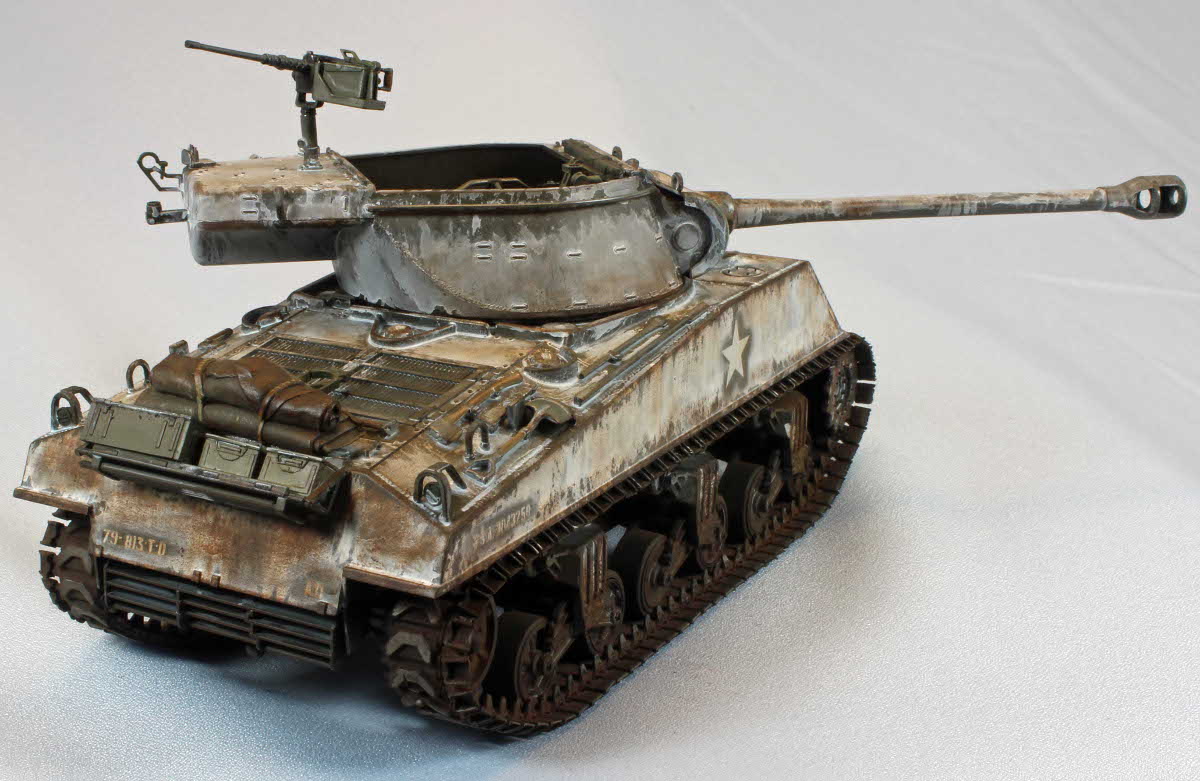
The vehicles first appeared in the European Theater of Operations (ETO) in September of 1944. The need for 90 mm-gunned tank destroyers was so urgent that from October to December 1944, 187 conversions of standard Medium Tank M4A3 hulls, designated M36B1, were rushed to the ETO and used in combat alongside standard M36s. The M36 was well liked by its crews, as it was one of the few armored fighting vehicles available to US forces that could destroy heavy German tanks from a distance. In an engagement with a German Panther tank at 1500 yards, a M36 of the 776th TD Battalion was able to penetrate the turret armor. Crews of the M36 found that it was better to target the turret rather than the glacis plate. In addition, crews found the Panther tank to be vulnerable when hit from the side.
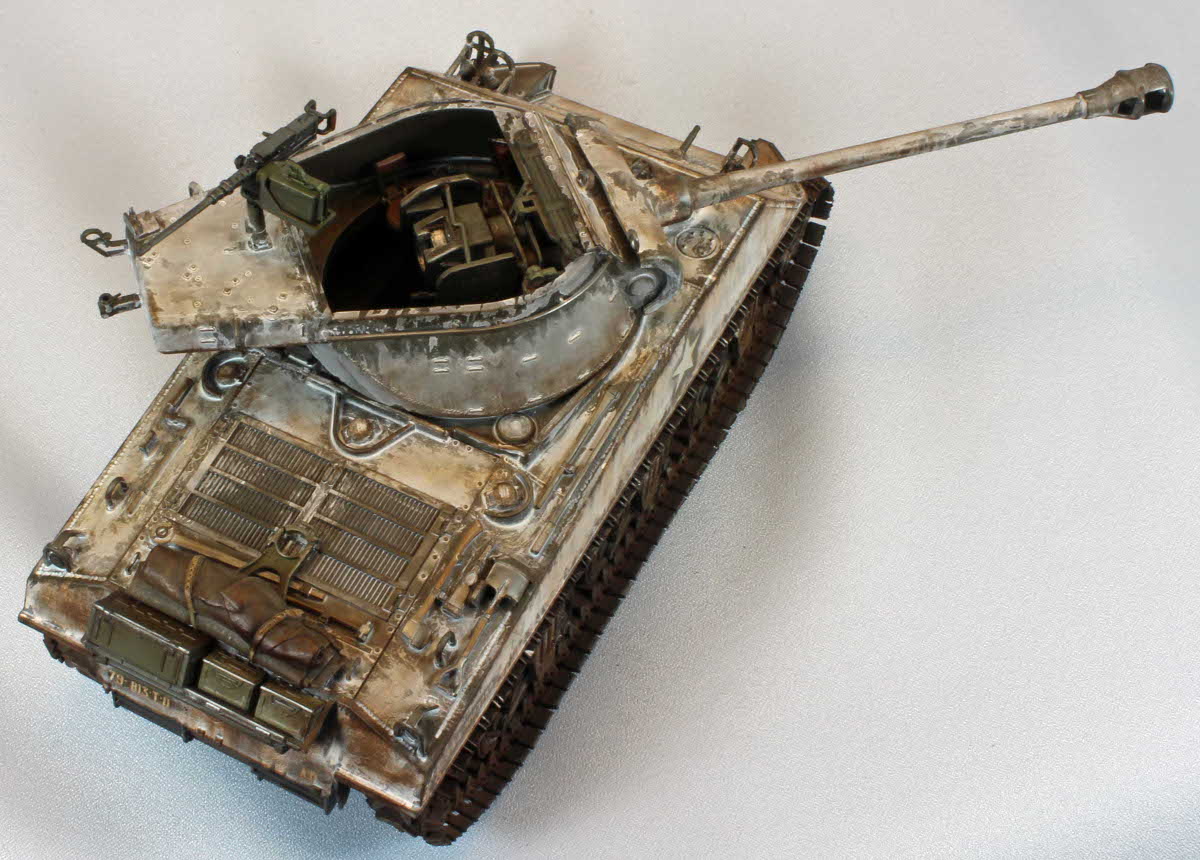
What's in the Box
10 sprues of soft, dark green plastic.
2 lengths of black, one-piece 'rubber-band' track.
1 piece of white twisted cotton string.
1 small sheet of decals.
1 small sheet of photo-etch containing optional headlight grates.
Separate upper and lower turret, and lower hull, individually wrapped.
Two separate instruction sections, totaling 12 pages with 20 steps, printed in black and white.
The slightly thick decals are printed by a Korean company, and are in perfect register. Two three-view drawings are included, representing two color schemes, both described as 'Unknown area, early 1945'.
Color callouts include Humbrol Enamel, GSI (Gunze) Creos Acrylic, GSI Mr. Color Lacquer, Life Color, Testors/Model Master Acrylic and Enamel, Revell Acrylic and Enamel, and Vallejo Model Color and Model Aire paints.
Things to consider before starting
Academy provides a lot of wheel options, including optional drive sprockets and return rollers. I suggest you separate what you want to use and move everything else far away. Things can get confusing otherwise. Academy thoughtfully provides the rubber portion of the wheels as separate parts to help with painting and finishing. If you choose to paint them separately you will need to consider several painting steps before assembly, and then mask the bogies before painting the rest of the vehicle (or leave them off until the end). I did not paint the wheels and tires separately in this build.
You will need to widen the M4A3 turret ring in Step 6 to accept the larger M36 turret. What seems like a lot of work goes by quickly since Academy does half the job for you by providing a deep cut line on the inside of the turret. I suggest you do this first thing out of the box to get it out of the way.
The Instructions
Academy is generally pretty good with their instructions, with some exceptions which are pointed out where appropriate below. Since this kit is a re-release with some new parts, the instructions came in two parts, which was awkward. I separated all the pages and stapled them together to compose a coherent assembly sequence. On the good side, there is an excellent parts map, and a comprehensive set of paint call outs is included.
Construction
Lower Hull and suspension
Construction begins with the lower hull and suspension. Academy includes two options for the wheels (both early 'wagon wheel' types and later, solid types), and two options for the return rollers and drive sprockets as well. There are no surprises here: each bogie comes together well and the fit is perfect. The bogies assemble and attach in a way that allows them to be articulated for uneven surfaces.
Main Deck
In Step 8, you can choose to use the five, over-scale plastic headlight protection baskets or their photo-etch replacements. The p/e versions are no simple affairs, because of the odd shape of the baskets. I went with the original plastic versions to save time but in the end, I wish I had gone with the p/e. The plastic baskets are really thick and boxy and they don't look very good.
Academy provides detail on the inside of the two front hatches. They can be posed in the open or closed position. There is no detail provided inside the hull, however. There are 'cheat lines' all over the model to assist in the placement of various parts. Most are okay; the parts that fit there hide the lines. There are four squares (2 in the center of the front hull to the left of the machine gun and two in the upper corners) that don't receive any parts and should be sanded off before painting.
Turret
Academy includes some nice detail inside the open turret, and it's a good start for those who wish to super-detail the turret. There are two noticeable ammunition racks that have holes for the rounds but that's all. I went to my spares box and found six p/e "e nds"and glued them over six of the holes, leaving the rest empty.
There is likewise a wire spool attached to the inside of the turret that comes empty in the kit. I wound some 'hairless' string from my spares box to this spool to simulate cable. I stopped at Step 15 to paint the turret insides before I joined the top and bottom sections (please see the 'Painting' section below for the paints I used). Two barrel options are provided. Both are two piece 'split down the middle' affairs, one with a flash suppressor and one without. In Step 18, the instructions show to attach Part O36, but that part does not show up on any of the drawings and looks a lot like the rear end of the turret cover that adorned the M36 post War (also not called out in the instructions). The same applies for Parts O31 and O32, except that these two parts don't fit around the turret. They come close but are clearly made for another version. I therefore skipped Step 18 altogether.
Academy 'Accoutrements'
One thing I always like about Academy kits is that they include a variety of optional extras, and this kit is no exception. You get three different pedestal machine guns (two 50 caliber and one 30 caliber), four fuel cans, three water cans, at least five ammunition boxes, one crate, and a tow cable (made of twisted cotton string). I used one of the 50 calibers, two ammo cans and the crate, and tossed the rest into my spare parts box.
The Track
The two runs of track in this kit are made up of black, rubber-band style plastic with attached outboard grousers. Strangely, every 2 inches or so on the outside of the track there is a small rubber 'bump', or a clearly visible hole left behind by the bump, probably due to some manufacturing issue. Some modelers will want to replace the track with an aftermarket product simply for this reason alone, since filler is not practical with this material.
I decided to 'weather' my way to a solution and did so. Academy track is the kind that you must melt rubber 'pins' with a hot knife or screwdriver to attach the two ends of the track together. The problem is that with the high track tension common to American tanks like the M36, the connection will invariably fail. If not when you first stretch the track around the drive sprocket then later, when your model is sitting on the bench! I keep my trusty stapler around for just this type of repair and I add two big staples to keep things together, which means this model won't be entered into any competition no matter how good I am at hiding the staples. In my opinion there are just too many options for track these days to continue to rely on this outdated design.
Painting and Finish
The M36 is going to be U.S. Army green. I wanted to try a whitewash, however, so my Jackson will sport a white winter coat over that green.
Tracks
I started out with a primer coat of Gunze Mr. Finisher 1500 Black, followed by a filter coat of AK Interactive Track Wash that I applied by hand. Once that was dry I highlighted the teeth, track edges, and the wheel paths with a Q-tip soaked with Model Master Dark Anodonic Grey enamel. Finally, I added Mig pigments to dirty them up a little.
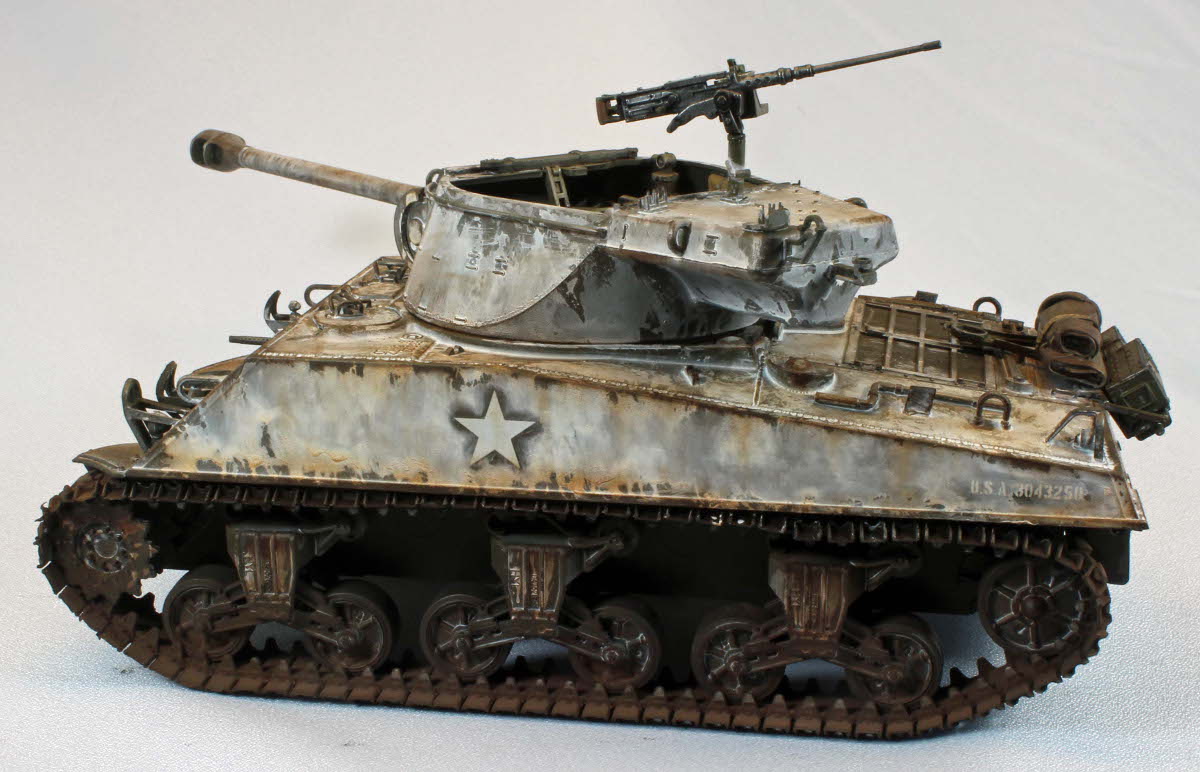
Turret Interior
After I finished Step 15 I stopped to paint the turret interior. After I gave everything a pre-shade coat of Gunze Mr. Finisher 1500 Black, I sprayed a light coat of the Vallejo Model Air 71.016 U.S. Dark Green, and then I went detailed the interior using Vallejo Model Color and Panzer Color Paints. (Note: When I hand brush Vallejo paints I put a drop of Vallejo 597 Slow Dry and a drop of water onto an old CD and then single drops of all the colors I will need. I mix the colors with the water and Slow Dry until the paint flows smoothly off a red sable brush.)
I painted the wooden portions of the seats and cushions 312 Leather Belt and then drybrushed them with Model Master 2103 Afrika Dunkelgrau. I painted the fire extinguisher 73.605 German Red Brown Surface Primer. I painted the rolled up tarp 314 Canvas. I then gave everything a filter coat with Mig Wash Brown and Mig Dark Brown. After I painted the detail, I went over the edges with a silver quilter's pencil to bring out the metallic 'bling': I focused especially on the floor and breech block. Once I was satisfied, I stuffed the turret opening with tissue to protect the work done so far and I carried on with the build.
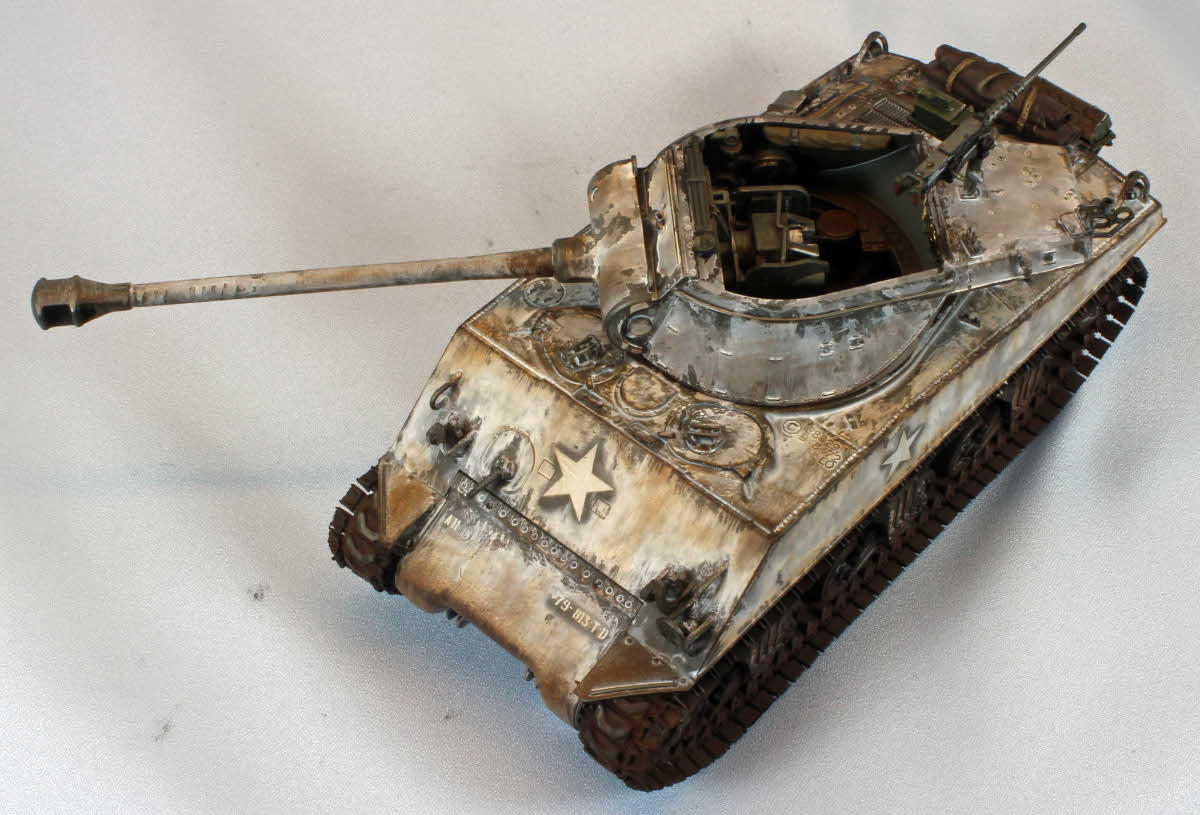
Machine Gun
I started by hand brushing the gun Tamiya Flat Black; this is the only time I ever use flat black. I then painted the wooden parts with Vallejo Panzer Aces 312 Leather Belt. Once the paint was dry, I dipped an artist's color shaper into some metal polishing powder from a company called USCHI (www.uschivdr.com) and I rubbed it into the surface. The more you rub the higher the shine. I painted the ammunition case Model Master Faded Olive Drab and used a silver quilter's pencil to highlight the edges of the case. Finally, I gave everything a filter using Mig Wash Brown thinned with Mona Lisa odorless thinner.
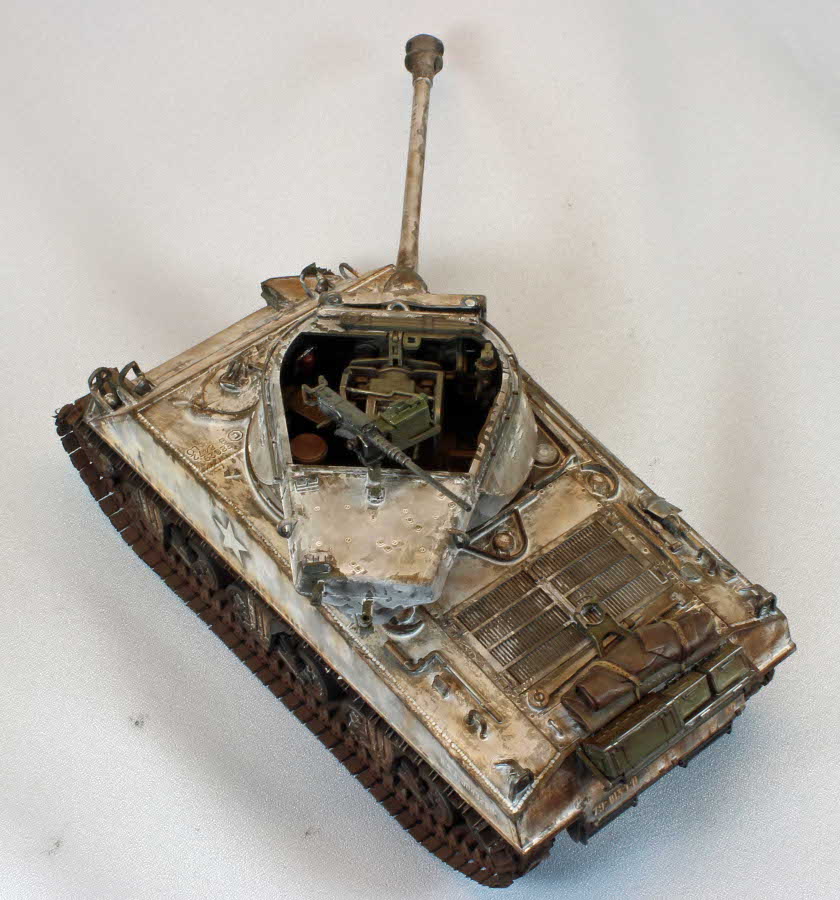
The rest of the model: Primer and Pre-Shade
I airbrushed a primer/pre-shade coat of Gunze Mr. Finisher 1500 Black to give the plastic and p/e some grip for the following coats, to fill in the recesses and create a shadow effect near the flat surface edges, which added depth for the subsequent coats. I gave the Gunze lacquer plenty of time to de-gas, since I would apply acrylics over it.
Using Vallejo Paints with a (syphon-feed) Paasche H Airbrush
I chose to use Vallejo Model Air colors on my Jackson, as part of my continued conversion to true acrylics. I went through a bit of experimentation up front, but I eventually found them to spray beautifully once I added a single drop of Liquitex Flow Aid and a good squirt of Vallejo Air brush Thinner to each cup. This recipe works well for any type of Vallejo paint, not just the Model Air line.
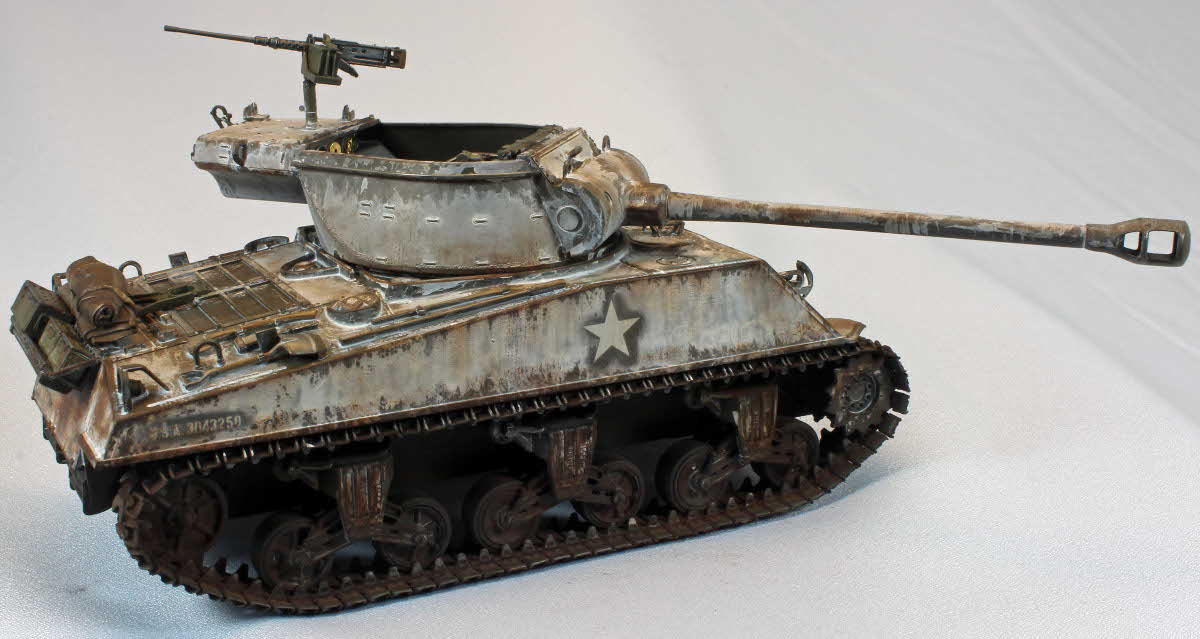
Camouflage and Decals
I followed the pre-shade coat with Vallejo Model Air 71.043 Olive Drab camouflage as a base for the subsequent white wash. This color has a little more brown in it than green. Once the acrylic coat had dried, I hand brushed a coat of Future on the areas that would receive decals. I applied the decals with the Red and Blue Micro Sol/Set system without any problems. I sealed them with another hand-applied coat of Future. I knocked down the shiny areas after I applied the Future by spraying Vallejo Matt Varnish to prepare the surfaces for the whitewash and filters.
On-Board Tools
I painted the wooden portions of the on-board equipment with Vallejo 310 Old Wood and the steel portions with Vallejo 70.865 Oily Steel. I brushed on a little Mig Wash Brown Oil straight from the tube and let that set overnight, to give more depth to the wooden parts of the tools. In the morning I carefully removed most of the oil paint with a Q-tip dampened with Mona Lisa. I left the areas near the buckles and metal parts darker than the wooden shafts. I dropped a single drop of Mig Black wash onto the flat surfaces of the steel parts to give them more depth; I feel this gives them a good, used look. I painted the two ammunition boxes Vallejo 71.044 Light Grey Green and the steel crate Vallejo 71.016 U.S. Dark Green.
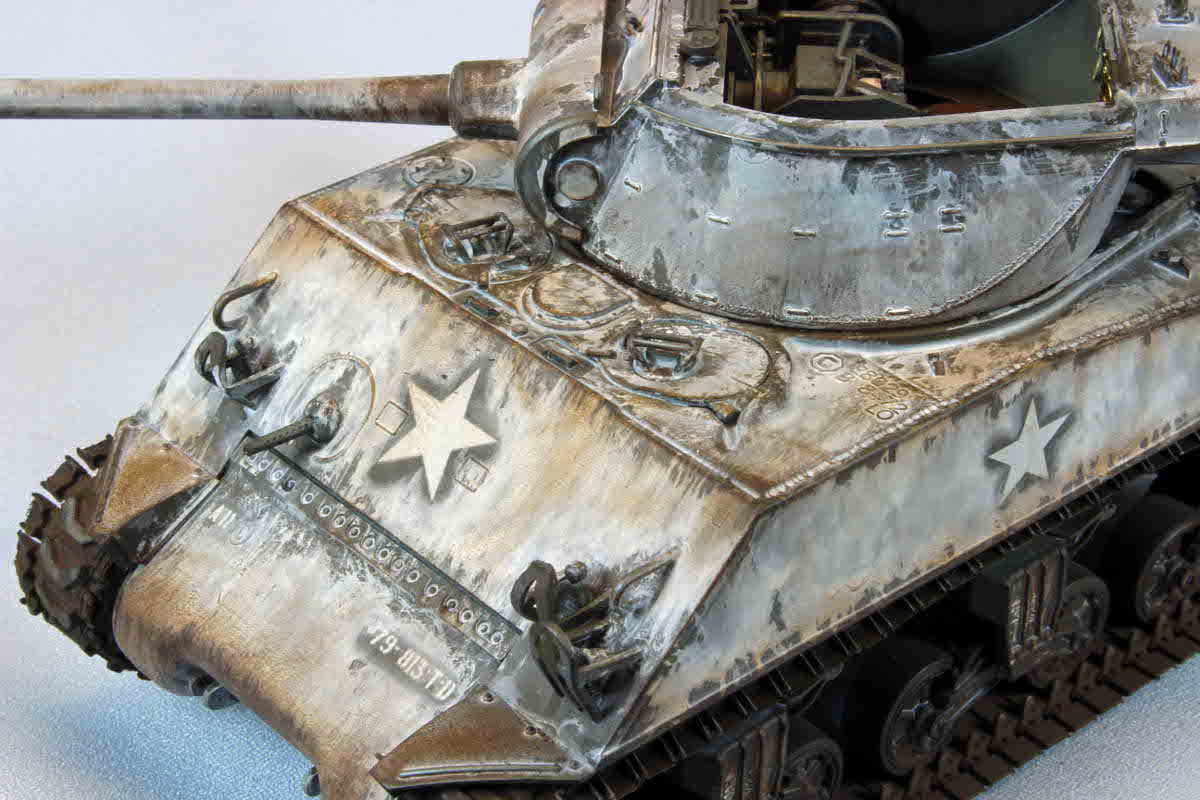
Whitewash
I created the whitewash by dabbling on Mig Winter Camouflage Wash straight from the bottle. I worked in sections, making sure nothing looked even or symmetrical. Then I mixed some Windsor Newton White Gouache with water and dabbled that in places to create more opaque areas. I like gouache for both its chalky texture and versatility. The rough surface is perfect for future dry-brushed highlights.
Dry Brushing and Pigments
I went to work with Old Holland Warm Sepia Extra to dry brush the entire vehicle. I focused on the edges and protruding detail, once the paint was thoroughly dry. Old Holland's oil paint, which I learned about in Tony Greenland's excellent 'Panzer Modeling' book, is the perfect hue and the pigment for this kind of work, and its pigment is as fine or even finer than Mig's products. After highlighting the track and road wheels with Mig pigments, I stuck it with a fork: this beefy tank-killer was done!
Conclusion
The M36B1 Jackson is a welcome addition to Academy's excellent line of American tank destroyers. I assembled it without any surprises and the fit was excellent. Academy kits are a hit with beginners, because of the low part counts and little extras like providing very feint raised lines for easy surface parts placement. Academy included a photo etched alternative to the thick, over-scale headlight covers, so they are also targeting more experienced modelers.
If there is one drawback to the kit, it's the old style rubber band tracks. They had a number of minor, but hard to rectify manufacturing flaws. However the kit looks great, it goes together well, and it was fun to build. I can recommend this kit to all levels of model builders.
I would like to thank Academy Models and Stevens International for providing this kit for review, and to Internet Modeler for giving me the opportunity to build it.
